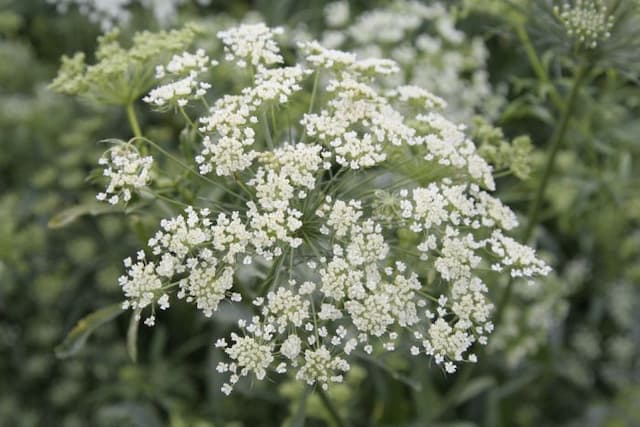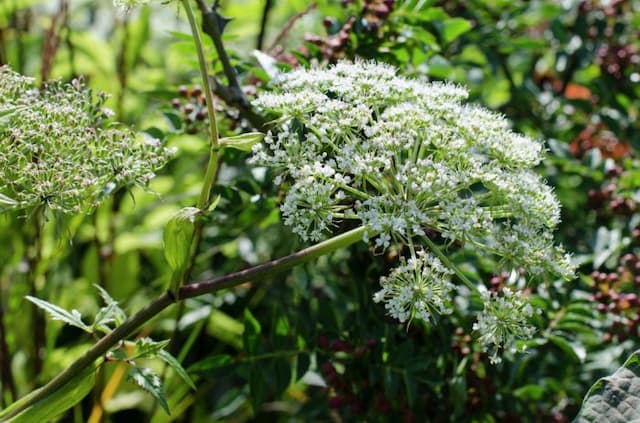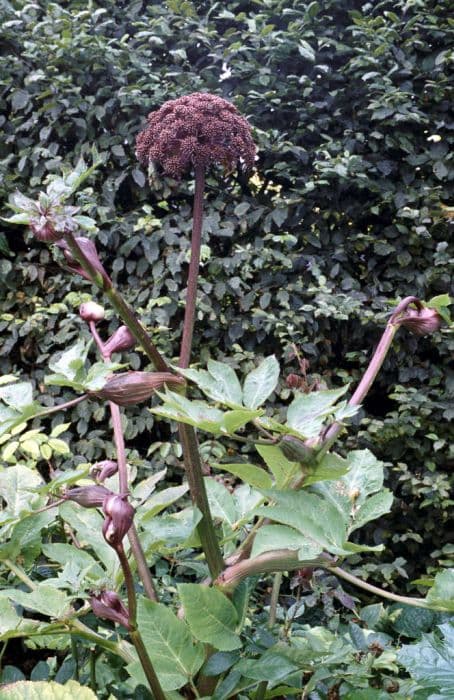Masterwort Astrantia 'Roma' (PBR)

ABOUT
Astrantia 'Roma', commonly known as Masterwort, is a perennial plant valued for its distinctive and charming flowers. The blooms are composed of small, cup-shaped flowers that cluster together to form a pincushion-like head, and these are framed by an elegant ruff of papery bracts. The color of the flowers is a captivating soft pink, imbued with subtle hints of green, which, overall, gives it a delicate and sophisticated look. The foliage of Masterwort is equally attractive, with each leaf deeply divided into lobes and having a textured, almost serrated edge. The leaves are a fresh green color, creating a perfect backdrop for the pink flower heads. During the blooming season, the plant becomes a focal point in the garden, displaying a dense cluster of these intricate flowers, which stand proudly above the foliage. Masterwort possesses a sturdy, branching habit with the flowers borne on slender stems. The plant's overall appearance, with its blend of graceful blooms and vibrant green leaves, makes it an excellent choice for garden borders, cottage gardens, or as part of a floral arrangement, where its unique texture and color can be admired up close.
About this plant
 Names
NamesFamily
Apiaceae
Synonyms
Great Masterwort, Hattie's Pincushion, Melancholy Gentleman
Common names
Astrantia 'Roma' (PBR)
 Toxicity
ToxicityTo humans
Masterwort, commonly known as Astrantia 'Roma', is not generally considered to be toxic to humans. However, sensitivity varies among individuals, and some people might experience mild irritation if they come into contact with the sap of the plant. Ingesting parts of the plant is unlikely to cause poisoning, but it is always advisable to avoid eating plants that are not typically recognized as food due to potential adverse reactions or unknown toxicity.
To pets
Masterwort is not widely recognized as a toxic plant to pets. There is limited information on its toxicity to animals, but it is generally not associated with serious poisoning in pets. As with any non-food plant, ingestion of large quantities could potentially cause mild stomach upset, so it is still prudent to prevent pets from consuming it. If you suspect your pet has ingested a significant amount of Masterwort and is showing signs of illness, you should consult your veterinarian.
 Characteristics
CharacteristicsLife cycle
Perennials
Foliage type
Deciduous
Color of leaves
Green
Flower color
Pink
Height
2 feet (60 cm)
Spread
1.5 feet (45 cm)
Plant type
Herb
Hardiness zones
5
Native area
Europe
Benefits
 General Benefits
General Benefits- Attracts pollinators - Astrantia 'Roma' is very attractive to bees and butterflies, enhancing pollination in the garden.
- Long flowering season - This plant blooms from early summer to early fall, providing extended visual interest.
- Low maintenance - It requires minimal care once established, making it ideal for busy gardeners.
- Drought tolerant - Once established, it can tolerate periods of dry weather, which can be beneficial in areas with water restrictions.
- Deer resistant - The plant is not favored by deer, which helps to prevent damage in gardens prone to deer visits.
- Good for cut flowers - The blooms of Astrantia 'Roma' make excellent cut flowers for arrangements with a long vase life.
- Architectural form - The pincushion-like flowers and mounding form add an architectural element to garden design.
- Versatile - Suitable for borders, cottage gardens, and woodland settings due to its adaptability and charm.
- Non-invasive - Unlike some garden plants, Astrantia 'Roma' does not spread aggressively, making it a good garden citizen.
 Medical Properties
Medical PropertiesThis plant is not used for medical purposes.
 Air-purifying Qualities
Air-purifying QualitiesThis plant is not specifically known for air purifying qualities.
 Other Uses
Other Uses- Astrantia 'Roma' can serve as a natural pest deterrent due to its strong scent, which some garden pests find off-putting.
- You can use Astrantia in floral art such as pressing or drying for craft purposes because of its unique star-shaped structure and enduring qualities when dried.
- The plant can be employed as a colorant for fabrics, with potential to create natural dyes from its pigments.
- Astrantia attracts beneficial insects like bees and butterflies, making it useful for supporting local ecosystems and pollination in gardens.
- The distinctive blooms of Astrantia can be used in photography for artistic imagery, providing an interesting subject for close-up plant photography.
- In landscape design, Astrantia can be used to create texture and depth due to its intricate flower heads and lush foliage.
- Astrantia's flowers can be utilized in culinary decoration, as some flowers are edible and can add elegance to dishes when used sparingly.
- It can also be incorporated into educational activities, such as botany lessons for children, to study plant anatomy and pollination.
- Astrantia flowers are sometimes used in the production of natural confetti, a biodegradable alternative to synthetic versions.
- The plant is sometimes used as a muse by artists and designers, inspiring patterns and motifs for textiles and wallpaper designs.
Interesting Facts
 Feng Shui
Feng ShuiThe Astrantia is not used in Feng Shui practice.
 Zodiac Sign Compitability
Zodiac Sign CompitabilityThe Astrantia is not used in astrology practice.
 Plant Symbolism
Plant Symbolism- Protection: Astrantia 'Roma', also known as Masterwort, traditionally symbolizes protection due to its use in folk medicine to ward off evil spirits and disease.
- Strength: The robust nature and hardiness of the Masterwort plant represent strength and resilience in the face of adversity.
- Courage: The Masterwort's ability to thrive in various conditions is often seen as a symbol of courage and bravery.
- Perseverance: Masterwort's long blooming season from early summer to fall suggests a theme of perseverance and enduring effort.
- Mystery: The intricate details and subtle beauty of Astrantia 'Roma' add a sense of mystery and fascination, symbolizing the hidden complexities in life.
- Unity: The cluster of small flowers that form the complete head of the Masterwort represents unity and togetherness, making it a symbol of harmony.
 Water
WaterMasterwort prefers evenly moist soil, so water regularly to maintain consistent moisture, particularly during dry spells. Aim to water deeply once or twice a week, providing about 1 gallon per plant each time, depending on weather conditions. During periods of heavy rainfall, reduce watering accordingly, and increase during hotter, drier weeks. Avoid overwatering as this can lead to root rot. Always check the top inch of soil for dryness before watering again.
 Light
LightMasterwort thrives in partial shade, where it receives filtered sunlight or morning sun and afternoon shade. The best spot for this plant is in a garden that mimics its natural woodland habitat, where it can be shielded from the harsh midday sun. An east- or north-facing garden is ideal to provide the light conditions Masterwort needs to grow.
 Temperature
TemperatureMasterwort can tolerate temperatures down to about 25 degrees Fahrenheit but prefers a range between 50 and 70 degrees for optimal growth. The plant's tolerance allows it to survive in USDA hardiness zones 4 through 7. Avoid exposing Masterwort to extreme heat or cold to maintain its health and vigor.
 Pruning
PruningPrune Masterwort after its first flowering to encourage a second bloom, typically by cutting back the spent flower stems to their base. In late fall or early spring, cut back any dead or damaged foliage to maintain plant health and appearance. Pruning is also essential to prevent self-seeding if volunteer plants are not desired.
 Cleaning
CleaningAs needed
 Soil
SoilMasterwort, or Astrantia 'Roma', thrives in rich, moist, yet well-draining soil with a pH range of 5.5 to 7.5. A mix of two parts garden soil, one part compost or well-rotted manure, and one part grit or perlite is ideal. This provides fertility and adequate drainage to prevent waterlogging, which is crucial for robust growth.
 Repotting
RepottingMasterwort does not need frequent repotting and can thrive in the same pot for several years. However, if growth slows or the plant becomes root-bound, repotting every 2 to 3 years in spring is beneficial.
 Humidity & Misting
Humidity & MistingMasterwort prefers average to high humidity levels. While it can tolerate a range of humidity conditions in the garden, ensuring good air circulation without overly dry air is beneficial for the plant's well-being.
 Suitable locations
Suitable locationsIndoor
Place Masterwort in bright, indirect light with high humidity.
Outdoor
Plant Masterwort in part shade, moist soil, shelter from wind.
Hardiness zone
4-7 USDA
 Life cycle
Life cycleAstrantia 'Roma', commonly known as Masterwort, begins its life cycle as a seed, which germinates in the spring when soil temperatures and moisture levels are appropriate. Once the seedling emerges, it develops a rosette of lobed, palmate leaves at the soil surface. As the plant matures, it sends up flowering stems in late spring or early summer, topped with pincushion-like inflorescences surrounded by bracts, which are typically a soft pink hue. After pollination, often by insects, seeds are produced which can be distributed to propagate the plant. Masterwort is a perennial, and post-flowering the plant will go dormant in the fall, dying back to the ground with the onset of colder weather. The plant's life cycle continues the following spring when new growth emerges from the rootstock, repeating the cycle.
 Propogation
PropogationPropogation time
Late Spring to Early Summer
Propogation: For Astrantia 'Roma', also known as Masterwort, the most popular method of propagation is by division. Division is ideally performed in either spring or early fall. To propagate through division, carefully dig up an established plant, then gently separate the clumps of roots into smaller segments, ensuring that each has several shoots and a good amount of root system attached. Once divided, the new clumps should be replanted at the same depth as they were previously growing, and watered thoroughly. This method is favored due to its simplicity and effectiveness, allowing gardeners to quickly increase their stock of Astrantia 'Roma' while maintaining the plant's genetic characteristics.









